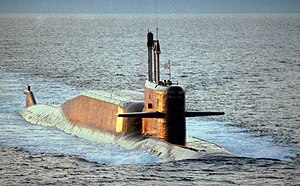
| External videos | |
|---|---|
| on RT Documentary Official YouTube Channel(in English) | |
The Delta class, (Russian: Дельта) Soviet designations Project 667B Murena, Project 667BD Murena-M, Project 667BDR Kalmar, Project 667BDRM Delfin, (NATO reporting names Delta I, Delta II, Delta III, Delta IV respectively) are a family of nuclear-powered ballistic missile submarines, designed and built in the Soviet Union, which formed the backbone of the Soviet and Russian strategic submarine fleet since their introduction in 1973. They carry nuclear ballistic missiles of the R-29 Vysota family, with the Delta I, Delta II, Delta III and Delta IV classes carrying the R-29/SS-N-8 'Sawfly', R-29D/SS-N-8 'Sawfly', R-29R/SS-N-18 'Stingray' and R-29RM/SS-N-23 'Skiff' (and later on improved versions) respectively.
The Soviets viewed the Deltas as an iterative improvement of the Yankee-class submarines, which carried R-27 Zyb missiles with a range of 2,500–3,000 km (1,553–1,864 mi). The R-29s gave the Deltas much needed standoff distance; with a range of 7,700 km (4,785 mi) the Deltas were able to perform their deterrence patrols within relative safety of the Arctic Ocean, while the Yankee-class had to patrol off the US coastline to do so. The Deltas were supplemented by the largest submarines ever built, the Typhoon-class submarines, which served as guarantors of the Soviet second strike capability. The earlier Delta boats remained in service until the 1990s, when the Soviet Union ceased to exist and many classes of submarines were decommissioned due to the severe budget cuts that resulted. A few Delta-IIIs and all of the Delta-IVs were retained by the nascent Russian Navy.
34 boats were built and commissioned during 1972–1990; approximately five or six remain active in 2023. A handful were converted into special-purpose submarines operated by GUGI.